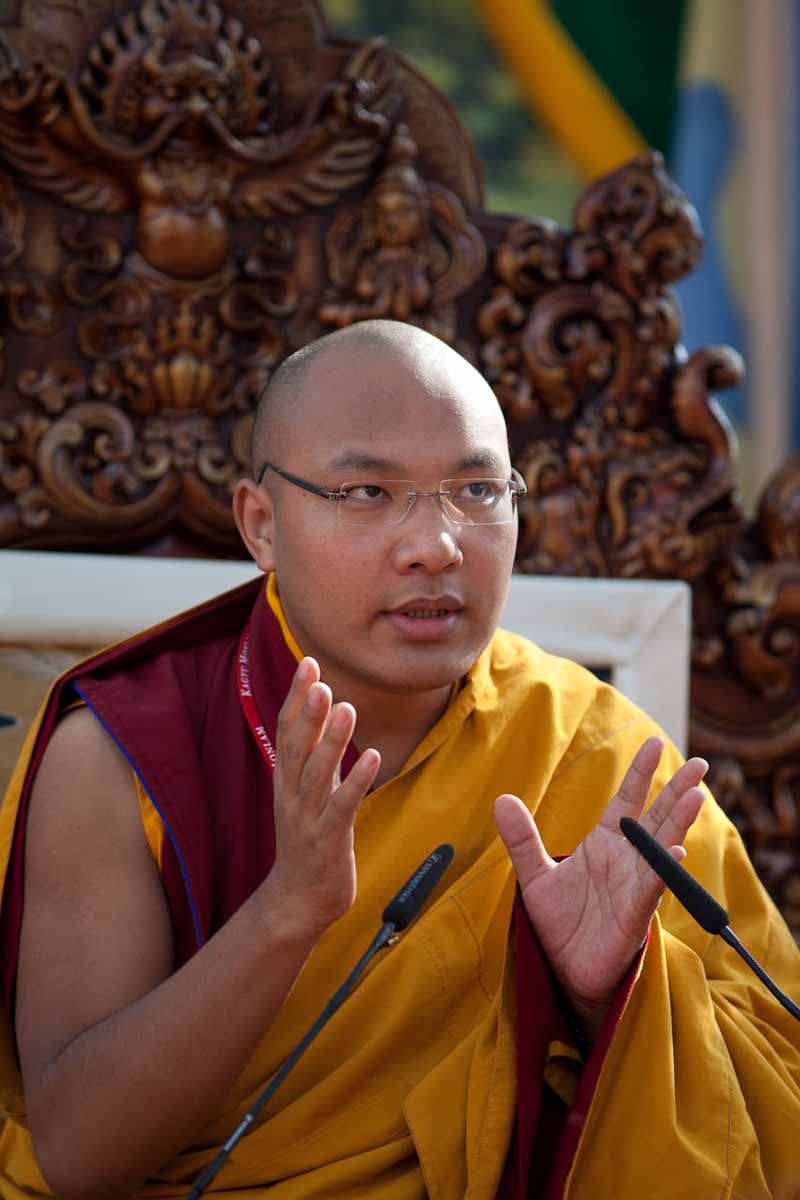法王新闻 | 2009年01月
『第26屆噶舉祈願法會』第三天日誌
『26th Kagyu Monlam』Day 3
時間:2009年01月06日 January 06, 2009
地點:印度 菩提加耶
報導:黃靖雅
攝影:噶瑪善治、噶瑪諾布 、班瑪歐色多傑
法王指導「淨化貪嗔癡三毒的禪修」
His Holiness Telling the Story of Milarepa
第一座法
上午6:00,嘉察仁波切陞座傳戒,傳授漢傳稱「八關齋戒」的「大乘布薩戒」。接著維那師帶領大眾以梵文念誦〈三常誦〉(大祈願課誦本無梵文版),再以藏文依序念誦:
1.〈皈依發心〉(大祈願課誦本P35)
2.〈祈願儀軌二十支〉(大祈願課誦本P38)
3.〈相好讚〉(大祈願課誦本P73)
4.〈慈氏讚〉(大祈願課誦本P101)
5.〈懺悔支〉(大祈願課誦本P144)
而後迴向,圓滿第一座法。
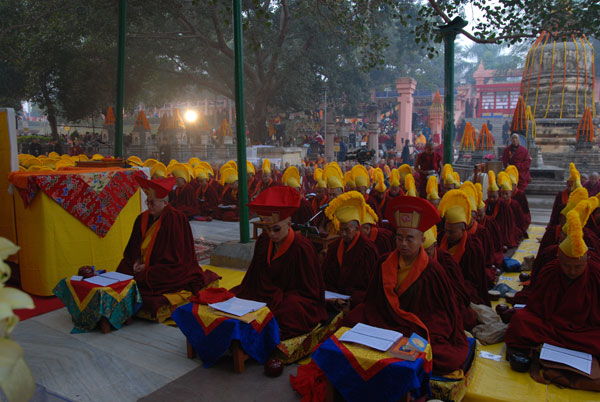
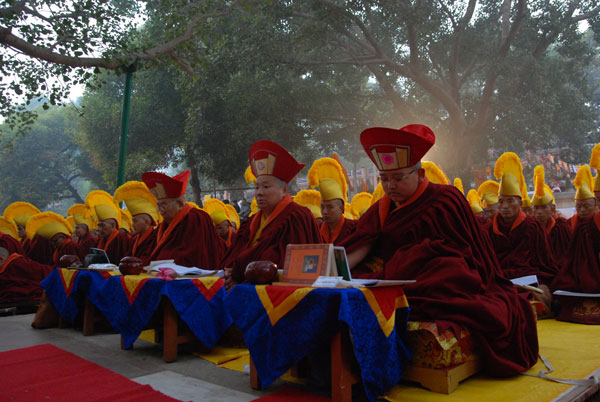

第二座法
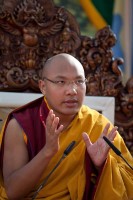
上午9:00,法王噶瑪巴陞座主法,開示之前,先舉行功德主供養儀式,再繼續講授「密勒日巴大師傳」,今天說到尊者閉關中精進修定,其中從不睡眠,有一日卻忽然睡覺,夢見已離開多年的故鄉,那四樑八柱之 屋已傾圮,家傳法寶《大寶積經》已荒蕪,親愛的母親已死,而妹妹流浪乞食,夢中大感悲傷,竟大哭而醒。醒來決意破關而出,準備稟告上師想回家鄉。
尊者回到馬爾巴大師處,想報告回鄉的決定,那時馬爾巴大師仍在睡眠,清晨的陽光照進大師房間,正好照在大師的頭上,師母達媚瑪也正好進來送飲食。馬爾巴大師一見尊者,問他為何破關而來,提醒恐是中斷 魔障,要他趕緊回去閉關,但尊者返鄉心意殷切,稟告決定後,馬爾巴大師觀察緣起說道:
你進來辭行之時,我仍睡眠,代表我們父子今生不會再相見;
陽光照進我房間,代表你的教法將弘傳;
陽光正好照在我頭上,代表修傳派的法脈將昌盛;
師母達媚瑪正好進來送飲食,代表你將來得享三昧定食。
馬爾巴大師就為尊者辦了一個送別的大薈供,席間大師變化出喜金剛、勝樂金剛等種種本尊身相,尊者當下決定要好好修行,以得到和尊者相同的神通。馬爾巴大師囑咐尊者,將來「應依雪山之山洞」及二十四個 聖地山洞為修行之依止處,這也成了尊者終身住山修持的緣起。
馬爾巴大師再留尊者住了些時日,把所有口訣傾囊相授,並回答了種種尊者修行上的疑難。最後殷殷交代尊者:「成就,才是最勝的供養,最好的利他。」並告訴尊者:「我們父子今生不會再見面,我們就在空行 淨土相見吧。」就流淚送別尊者。此時尊者因學了氣功,本來15天路程,3天就到了,回到家鄉果然見到夢中所見景象,見到了「無常幻化師」(無常以所示現的幻化相教導)。
當下起,堅持做個好人法王針對今天所說故事內容開示說,現代師徒關係和以前真是不同:現代有些上師會嚇唬弟子,不遵守三昧耶就會下金剛地獄;但我們看看馬爾巴大師,他對密勒日巴多慈悲啊,不但教弟子修持口訣,還照顧生活 飲食。所謂上師,不是坐在高高的法座上,就叫上師,而是要隨時顧念弟子,弟子不知如何取捨要幫助弟子。
所以,上師首先應該是個「好人」,法王說,一個好人懂得感念眾生恩德,了解這一生都是要依靠他人、依靠萬物才能生存,所以對身三口四意三(殺、盜、淫、妄語、惡口、兩舌、綺語、貪心、害心和邪見)的十 惡業,會自然、自發性的不做;對十善業,會生起自然的歡喜;對慈悲利他的善行,會自然的行持。就像達賴喇嘛對和平的努力,他慈悲利他的事業自然遍滿,讓全世界不能缺少這樣一位領袖。
法王說,如果你心意調柔慈悲,別人對你的態度也會變好,會和顏悅色、微笑相待。一個關愛世界的人,自然就會想到利他;而一個好人,他的心是無私的。「快樂之因,是善心;痛苦之因,是惡心。」所以法王鼓 勵大家:「就算全世界都是壞人,我也要做個好人。」因為在社會上精進,是不能沒有勇氣和堅持的。法王說,不管是出家眾或在家眾,都要記住永遠要保持對世界的尊重、關愛和信心,「不管這世界多昏暗,都要堅持 做一盞明燈。」這就是「善心」的意義。
「當下起,我就要成為一個充滿熱情、真誠的好人」,法王要大家如是發願,有些事雖然不符合世俗期待、社會價值,卻是符合諸佛如來的心要意趣。
接著,法王要大眾唱〈如何有益歌〉,大眾在維那師領唱下以藏文唱頌──
敬禮恩師馬爾巴前,在此集會諸徒眾,
聽汝老父密勒歌,最後咐囑應諦聽!
依於上師馬爾巴恩,瑜伽行者我密勒,
一切作業皆已畢。汝等後學諸徒眾,
應如我教而修行;十方諸佛皆歡喜。
我及諸佛歡喜故,自他事業皆成就;
違我所教諸行業,自他二利俱難成;
壞自他故我不喜。
若師不具淨傳承,求得灌頂有何用?
自心與法不相合,手持法典有何用?
若不捨棄世間法,依訣修觀有何用?
三業與法不相合,念誦儀軌有何用?
惡語利嘴不對治,修行忍辱有何用?
親仇愛怨不捨棄,縱行供養有何用?
自利之心若不除,徒行佈施有何用?
不識六道皆父母,寺廟雖佳有何用?
此心不生清淨見,修造佛塔有何用?
若難四時修瑜伽,造佛形像有何用?
心坎深處不祈禱,依時供養有何用?
心中若不化口訣,自討苦吃有何用?
死時不生大信心,觀摩佛相有何用?
不生悲哀出離心,捨此棄彼有何用?
不修愛人逾愛己,口說慈悲有何用?
若不降伏煩惱因,承事供養有何用?
若不持續上師教,徒眾雖多有何用?
無用無益之作業,招損惱故應捨棄!
所作已作我密勒,於諸煩擾無聊事,
無須多作可休矣。
大眾唱完,法王再針對道歌內容作簡短開示說,總的來說,我們修持要抓重點,不要光去做那些旁枝末節,卻失掉要點,「如果應取而捨,應捨而取,那就沒有任何利益了。」
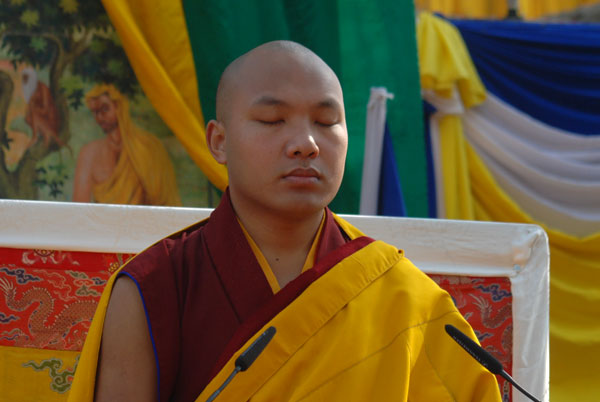
接著,是禪修。今天法王教大家「淨化貪嗔癡三毒的禪修」一開始法王仍先提醒身要,「你們禪修的時候要好好注意身要,別讓那洛巴的傳承丟臉。」
法王再次簡短提示禪修時身體應注意的要點:金剛跏趺坐,脊椎要直,下巴微收,眼睛看著鼻尖的虛空(但別太用力看,會翻白眼),手持定印(手掌右上左下,亦有左上右下的,但今天我們採右上左下,大姆指 相扣),兩臂不要緊貼身體(因為腋下有昏沈穴,稍稍打開透風才不會昏沈)。
法王接著說,我們今天要做的是淨化貪嗔癡三毒的禪修,禪修本來就是要淨化三毒的,但也別指望像用鐵錘一樣,噹一下把三毒打掉,要用禪修讓心漸漸習慣、熟練。
現在,觀想額頭、心輪和肚臍三個位置──
在肚臍有如水的貪聚集,
在心輪有如火的嗔聚集,
在額輪有如黑煙的癡聚集,
再觀想前方虛空中有佛陀、上師或你敬愛的人,
從他的額、喉、心三輪放射白紅藍三色光,
照射到行者身上的貪、嗔、癡三聚集處,
心中要同時祈求佛陀、上師淨化我們的貪嗔癡三毒。
法王開玩笑的說:「我祈求各位這就樣禪修5分鐘,別睡著。」
大眾寂靜安住,禪修五分鐘。
接著,法王獨誦〈大祈願文〉。而後大眾迴向,圓滿第二座法。
法王離開法會會場後,隨即赴法會期間兩個義診地點:寧瑪寺和菩提迦耶觀光局旁的義診點,巡視僧俗二眾應診情況。
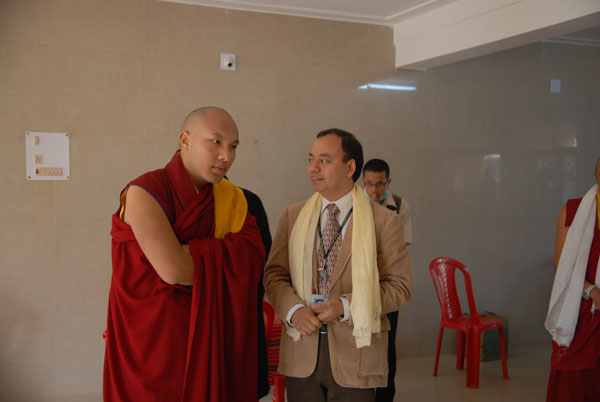
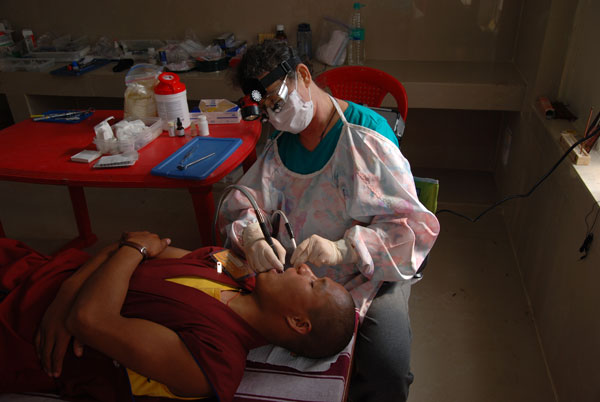
隨後前往德噶寺,到廚房巡視供養僧伽的膳食製作情情,並慰勞義工人員;中午並在德噶寺大 殿應供,與噶舉傳承諸大仁波切,以及比丘、比丘尼眾一起用缽飯,用餐之前並作開示,嚴格要求僧眾注意行住坐臥威儀,提醒用缽飯時,缽要持端正等要點,現場比丘、比丘尼眾都凝神諦聽,偌大大殿,一片寂靜。
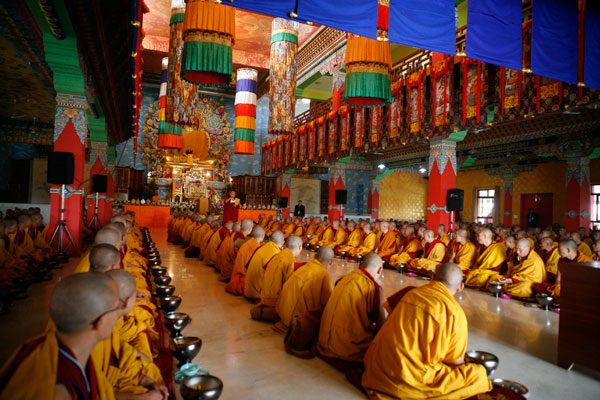
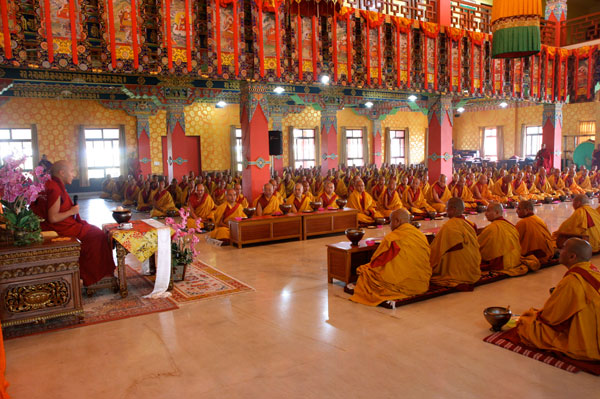

第三座法
下午1:30,維那師帶領大眾念誦《華嚴經》〈普賢行願品〉(大祈願課誦本P194)。
而後迴向,圓滿第三座法。
第四座法
下午3:30,維那師帶領大眾念誦──
1.〈直貢噶舉觀音願文〉(大祈願課誦本P391)
2.〈無分別持教長壽願文〉(大祈願課誦本P274)
3.〈長壽願文〉(見長壽文本)
4.〈護法供儀〉(大祈願課誦本中文無)
5.〈雪域安樂願文〉(大祈願課誦本P460)
6.〈吉祥文選〉(大祈願課誦本P282)
7.《月藏經》(大祈願課誦本P269)
而後迴向,圓滿第四座法。
The relationship between Marpa and Milarepa was unlike an ordinary lama-student relationship. Some lamas threatened their students that if they didn’t follow through instructions they would be breaking samaya, and so would go to a hell realm. In contrast, Marpa treated Milarepa like a son. Nor was he motivated by gain. A lama should skillfully nurture his students and always be compassionate.
His Holiness went on to discuss tsultrim – ethical conduct. He explained that rules of good conduct such as not stealing or not killing should be understood not as a codex, a set of laws to be observed, but rather as a description of the behavior which was necessary if we wanted to be happy. Ethical conduct was also essential for the well-being of the society in which we live. He reminded everyone once more of the interdependent nature of our existence. Throughout life we are dependent on others. We were born because of the love our parents had for each other. They cared for us and did their best for us. At every stage of our life, when we were born, as a baby, at school, when looking for work, when we were ill, we relied on others to help us. It was impossible to live completely independently. Given this interdependence, we should never ever look down on other people or show them disrespect. We should never intentionally harm others. It was very difficult to live in a society where people disrespected and harmed each other.
His Holiness cited two reasons for engaging in ethical behavior.
The first was our responsibility to transform the society in which we lived because we were dependent on all the other members of that society. If it were full of negativity, non-virtuous actions and a general lack of compassion, there would be so much suffering and so many difficulties that we would find it very hard to live in a peaceful and positive way.
The second was that if we did not guard our own values, we might be ousted from society. Therefore we had to maintain ethical discipline, which meant practising the ten virtues of body, speech and mind. [The three related to the body are to abstain from killing, stealing, and sexual misconduct; the four related to speech are to abstain from lying, from slander, from harsh speech, and from gossip or meaningless talk; the three related to the mind to be avoided are covetousness, malice and wrong view. ] However, His Holiness commented, it was self-evident that a good person would not kill or rape. When society had to make laws to control behavior it was as a last resort.
Living by these ten virtues we could transform both our own lives and society. As a matter of fact, we didn’t have much choice in the matter, because positive deeds produced positive results. Those people who do great things for the good of others – such as His Holiness the Dalai Lama – are highly respected by other people and seen as indispensable to society. On the other hand, those who always engaged in negative actions were not respected, were viewed as bad people to be avoided, and ostracized. By engaging in good behavior we could bring peace and smiles to the faces of other people.
Many people had a tendency towards negative actions. People were often very selfish and believed that through negative actions they would fulfill their wishes very quickly. In contrast, those who did positive deeds were considering the well-being of lots of people; they were concerned for the welfare of the world and society. As dharma practitioners we should want to bring peace and well-being to all sentient beings. If things weren’t going well, we should remember the first line of the four immeasurable: “May all sentient beings be happy and have the causes of happiness”
This was not just a great aspiration, it was also something which was achievable. But we had to take action. In which case, what should we do? Basically we had to practice virtue, work on transforming our minds, and change our behavior. There were many types of virtuous actions described in the Dharma, but some were culturally dependent or archaic. The baseline was to be somebody who refrained from non-virtuous actions.
His Holiness went on to say that he thought people who committed suicide sometimes did so because, without help and support and with no one to love us, it was too difficult to live in such a gloomy world. He expressed some amazement that in some countries there are now self-help books on committing suicide. This was indicative of society’s failure. In the past, life used to be viewed as the most precious thing, but now knowing how to commit suicide had become a necessity.
Our responsibility, however, remained the same. Even if the whole world was filled with negative people and actions, still we had to do good. We had to make the aspiration to live truthfully and act ethically, showing love and respect to all other sentient beings. These days society was very difficult and full of falsehood, but without good people the world would lose all hope. Whether we were male or female, lay or ordained, we needed courage, sincerity and the commitment to be a good person. It wouldn’t be easy. Yet, however dark the world might be, we had to be a small lamp in that dark. From now, everybody had to take on that responsibility from today.
After singing another doha His Holiness instructed everybody in a short meditation focused on rooting out the three poisons. When you practiced Dharma, he told everyone, it was important to aim the arrow in the direction you wanted to go, and reminded the assembly that they were the lineage holders of Panchen Naropa and should not disgrace his name. If you did nothing about the three poisons, he advised, your dharma practice would not be Dharma. These three poisons could not be destroyed in one go; you had to work on them day by day. He gave the following visualization of the three poisons.
At the navel is a blue pool or lake which represents attachment, because it is as if we drown in it. At the heart is a red fire representing hatred and aggression. At the forehead is blackness and darkness in the form of smoke or a cloud. This represents ignorance.
In the sky above is Buddha Shakyamuni or your own root guru. You request blessings from his body that all 3 mind poisons be eliminated. From his forehead a pure white light radiates, from his heart centre a red light radiates, and from his navel a blue light. Visualise the blue light entering your navel, the red light entering your heart, and the white light entering your forehead, thus eliminating all three poisons.
So once more, in front of the bodhi tree, in the shadow of the Mahabodhi temple, the Gyalwang Karmapa led the Kagyu Monlam assembly in five minutes of meditation, before concluding the morning session with The Great Aspiration Prayer.
Consecration ceremony at the Bangladeshi Buddhist Monastery
After attending the morning session of Kagyu Monlam at the Mahabodhi Temple, and giving a teaching on The Songs of Milarepa, His Holiness went on to the Bangladeshi Buddhist Monastery. There he lit candles and at the shrine to bless the shrine room, and chanted prayers with the resident monks, who belong to the Theravadin tradition. He then consecrated a new Buddha statue in the monastery grounds.
